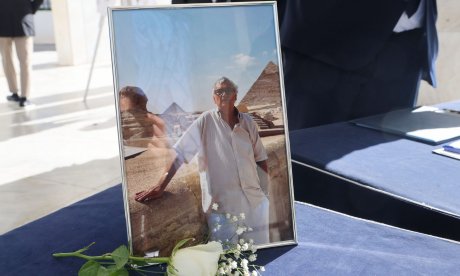Danger of Disinformation by Radical Islamists in Bangladesh
The flooding in Bangladesh is primarily due to heavy monsoon rains. India's Ministry of External Affairs (MEA) has firmly rejected these allegations, stating that they are factually incorrect and misleading

Many districts in eastern Bangladesh have been flooded in recent weeks by rain brought on by a heavy monsoon. However rumours circulating on social media have claimed that the flooding was "artificial" or exacerbated by India opening dams and barrages on rivers near the border with Bangladesh.
Radical groups like Hefazat-e-Islam, known to spread various rumours and misinformation have been falsely accusing New Delhi of releasing water from the Dumbur Dam, situated in the Indian state of Tripura, on the Gomati River that flows from India into Bangladesh. These allegations are part of a broader pattern of using misinformation to stir up public sentiment and achieve their political and ideological goals.
Without any proof, even responsible ministers in the Interim government like Mohammad Nahid Islam, Bangladesh's Information and Broadcasting Affairs adviser have been stating that India opened a dam without issuing any prior warning and giving Bangladesh scope to prepare.
Of course these false claims have been debunked. The flooding in Bangladesh is primarily due to heavy monsoon rains. India's Ministry of External Affairs (MEA) has firmly rejected these allegations, stating that they are factually incorrect and misleading. The MEA emphasised that there is regular and timely exchange of data and critical information between India and Bangladesh regarding water management. MEA statement said, "The flooding is due to waters from the catchment downstream from the dam, which is located over 120 kilometres upstream from the Bangladesh border." The statement also said that due to heavy rain since August 21, "automatic releases have been observed."
While lots of original pictures and videos of the ongoing flood in Bangladesh have been shared online by many people, several social media posts have also been sharing old pictures, falsely claiming they are from the recent floods in Bangladesh.

In yet another Facebook post, a user claimed that the Noakhali district had been flooded with water and posted three pictures to support this claim.
The area of the Noakhali district has been hit by flooding and now has further deteriorated due to continuous rainfall and water flowing from India. However, not all pictures shared in the post are authentic.

The first picture is from Bangladesh, but it is from Sylhet, not Noakhali, and it was taken by Getty Images in June of this year.

A social media user posted a video that is more than two years old, falsely claiming it shows a recent dam opening by India
It's important to rely on verified information from credible sources to understand the true causes of such natural disasters. In fact the India Meteorological Department (IMD) had issued warnings about the weather conditions affecting Bangladesh. The IMD has been closely monitoring the situation and providing updates on the potential impacts, including heavy rainfall and strong winds. It informed the Banglaeshi interim government that a depression over the northeast Bay of Bengal moved west-northwestwards and crossed the Bangladesh coast near Patuakhali.

Many users on Bangladeshi social media have posted videos of a dam releasing water, claiming it to be the Dumbur Dam in the Indian state of Tripura.
However, the dam in the video is actually the Srisailam Dam, located in the Indian state of Telangana, near the temple of Srisailam. There is in fact an old video from 2020 attached to Google Maps as well. By comparing the videos one can clearly see that both dams look completely different. From social media pictures it is difficult for unsuspecting people to differentiate between the Dumbur Dam and any other.

There is in fact an old video from 2020 attached to Google Maps as well. By comparing the videos one can clearly see that both dams look completely different. From social media pictures it is difficult for unsuspecting people to differentiate between the Dumbur Dam and any other.
Another clue is the weather, which looks quite good in the video, with a clear sky. However, Tripura and many parts of Bangladesh were facing heavy rains in the last few weeks and the skies were cloudy in that region. Furthermore Dumbur Dam in the Gomati River is 120 kilometres away before it reaches the Bangladesh area.
Continuous heavy rainfall has led to severe flooding and landslides, resulting in the loss of lives and displacement of many people in the entire Northeast India, causing significant devastation, particularly in states like Assam, Tripura, and Manipur. In Assam, the Brahmaputra River has overflowed, affecting numerous villages and causing extensive damage. The Indian Army and Air Force have been actively involved in rescue operations. In Tripura, the state government has declared the entire state as a Natural Calamity Affected Area, with ongoing relief efforts to support the affected population. The situation remains critical, with weather agencies warning of more heavy rainfall and potential flash floods in the coming days.
Flooding in South Asia often occurs due to the region's shared river systems. Implementing water-sharing treaties between India and Bangladesh has been quite complex due to several challenges. Bangladesh has often accused India of causing floods in their country, especially by releasing water from the Farakka barrage, which stands on the river Ganges. India has insisted that Bangladesh for not having an adequate flood control system.
The flow of rivers can vary significantly between seasons, making it difficult to ensure a consistent and fair distribution of water throughout the year. Changes in climate patterns can lead to unpredictable rainfall and river flows, complicating the management and allocation of water resources.
Both India and Bangladesh rely heavily on agriculture, which requires substantial water. Increasing populations in both countries put additional pressure on water resources, leading to higher demand and potential conflicts over water usage.
Effective water management requires robust infrastructure and technology for monitoring and distribution. Inadequate infrastructure can hinder the implementation of treaties. Trust and cooperation between the countries are essential but can be difficult to maintain, especially when political dispensation in Bangladesh is prone to spreading disinformation about India.
The second picture is from the Indian state of Assam, where floods occurred in June this year. The Indian newspaper Times of India posted the same picture, which was taken by the news agency Reuters. The third picture remains unproven as it does not have enough clues to check its authenticity.
Professor Ainun Nishat, a river and water management expert based in Dhaka explains, ''Bangladesh is a flood deltaic region,"... "So, we depend on flood embankments or flood dikes for managing floods in our own country. Unfortunately, these were constructed mostly in the '60s, '70s, and 1980s, and unfortunately, their maintenance has been very poor. The result is the embankment breach, and the flood enters."
Flood preparedness and infrastructure in Bangladesh have been long-standing challenges. The country is highly vulnerable to flooding due the presence of numerous rivers. Many areas lack proper drainage systems, embankments, and flood barriers, making them susceptible to flooding. The resources available for disaster management and relief are often insufficient to meet the needs during major flood events. Rapid urbanisation without adequate planning has exacerbated the problem, leading to increased flood risks in urban areas.The interim government, led by Prof. Muhammad Yunus, has been criticised for its lack of preparedness and slow response. Despite efforts to coordinate relief with the Army, Navy, and other agencies, many flood victims have struggled to receive adequate support. For the interim government rather than addressing these shortcomings, it has been easiest to accuse India of opening the floodgates.
There have been reports of increased anti-India sentiment in Bangladesh, particularly following political changes and unrest in the country. Radical groups like Hefazat-e-Islam and Islamic influencers have launched campaigns to spread misinformation, blaming India for various issues, including floods.
It’s troubling to hear about such hostile rhetoric being spread by radical elements in the media. Disinformation and inflammatory language can exacerbate tensions and create unnecessary animosity between the people of Bangladesh and India. Such rhetoric can damage diplomatic ties and make cooperation on important issues more difficult. It can influence public opinion negatively, leading to increased mistrust and hostility.
It’s also troubling when there is a lack of clear communication from Yunus’s interim government during such critical times. Transparent and accurate information is essential to prevent misinformation and ensure public safety. In times of natural disasters, like floods, misinformation can hinder effective response and relief efforts, exacerbating the humanitarian crisis.
There are already reports that the Yunus government is potentially encouraging radical elements. Groups like Hefazat-e-Islam and Jamaat-e-Islami have been known for their hardline stances and actions that can destabilise the region. Under these circumstances, as interim Prime Minister Muhammad Yunus has a responsibility to ensure that all groups operate within the law and do not incite violence or spread misinformation. Unless this happens, the government will be hand in glove with Islamists in the dissemination of disinformation about India, which can further fuel radicalisation and extremist activities, posing security threats to both nations.
Trending
.jpg?t=rgXbimPa9UfzIW7v6JcY1A)



















